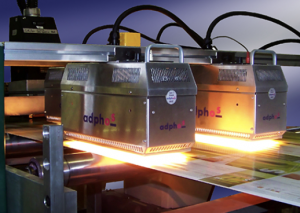New Inkjet Printing Solutions On Plastics
Dr. Kai Bar, Managing Director and President of adphos, recently discussed how the drying and pre-post-print processing can influence or even drive successful inkjet printing on plastics for packaging applications.
The adphos Group is a family of privately owned companies focused on the development of adphosNIR thermal drying technology which dramatically reduces the time and space required for thermal processes.
With the plethora of specific applications and materials used in printing solutions nowadays, there is not one type of printing method that works for all jobs. For example, water-based inks, is it partially/mostly approved for food and cosmetics; high print quality (>600dpi) or largecolor gamut (>4 colors), all interconnect including substrate type, in-type, and pre-post print processing.
Inkjet printers are a complex system, not simply within the confines of its own machinery. This technology works on a spectrum, and with it comes the substrate complexes NIR driers can accommodate to an active site, such as water based pigmented paint – often used in the food, beverage, and pharmaceutical industry.
This is an important advancement in the way of printer ink technology. Fast drying ink is an extremely important process for large scale label operations looking to cut down on slow lead times and increase their bottom line. With all the new technology out there, it can be difficult to decipher the pros and cons of the right equipment and material needed to upscale a growing business, but the demand for faster inkjet technology is out there, and it’s only getting stronger.
New Print Drying Technology
As of late, UV-ink-based printing solutions have been deemed necessary for label and industrial or non-direct contact food/cosmetic applications of non-absorbent/plastic substrates.
Potential drying technologies for water-based inkjet inks are hot air convection dryers (these can be combined with hot drum/hot plate conduction syste
ms), infrared (NIR, short, mid-wave) heated drying coupled with hot air moisture removal, and adphos’ advanced NIR (aNIR) technology. aNIR is a proprietary platform technology based on high-energy photon energy (emitted in the near-infrared spectrum), with integrated independent adjustable high-speed warm air ventilation.

adphos’ NIR-based solutions enable the drying of wet inks by using direct photonic contact. The results are almost instantaneous, as the water molecules evaporate with the integrated WAV (Warm Air Ventilation). The drying process is within a fraction of a second (<<1s)
The Chemical Components in Plastics
Colors have characteristics that affect the varying absorption rates and heating processes for instance, the PH content. Prevents a fully printed CMYK layer from ever drying at the same time. The black or dark patterns will always dry easier than the lighter (especially yellow) colors.
If intercolor drying is applied, the heat intensity for each of the different colors can be controlled, improving the quality of the temperature-limited substrate and preventing overheating. This is a crucial part of the thermal heating process.
All material shows some type. of thermal applied mechanical stress. Plastics are no exception. At a higher tension, a lower temperature can be applied to the specified plastic substrate, and a thin plastic substrate contains even less web force than a thicker substrate.
Hot drum/hot air based drying solutions offered to the market require a drying length of 10m for print speeds up to 75m/min and require B2 inks (non-tacky after completed drying process).
For high temperature plastic materials (≥80°C) for all ink classes, aNIR-based drying solutions that do not limit print performance capabilities are commercially available.
aNIR dryer-based inkjet print processes are three times the speed of existing UV-based printing performances. Therefore, the high-end flexible packaging marketing is the most attractive in terms of needed demand.
NIR Print Drying, is it Right for You?
Packing print solutions are always changing. There has been a true rise in the attractiveness or high-print volume markets, particularly when it comes to furthering the growth of inkjet printing. The drying process of prints is just as important as the high quality inks one prints with. Why cut down on the quality of the print when the technology is there and ready to be used?
With this market comes the necessary specifics; varying substrates/size/speed requirements explain why a one size fits all approach does not always work.
With how quickly the market is adapting to the age of inkjet printing, materials such as water based pigmented inks can be dried with new technology like convection dryers to create a chemical reaction, using high grade drying techniques to instantly dry complex die-based coatings for a wide range of substrates.
To overcome these processes, aNIR technologies have adapted to the market in order to be applied to the correct combination of inkjet technology. This can be used to create high end, flexible packaging, adding to its durability, quality and overall performance, offering a tangible and complete print drying solution between every run.
